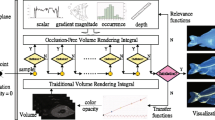Abstract
An adaptive sparse texture rendering method is proposed to solve for occlusion effects when visualizing 3D flows, building on an extensible fuzzy feature extraction approach. First, the flow feature is described by fuzzy theory and rules for some typical features are obtained. The significance value for each voxel is then calculated by a clustering method under the minimum square-sum rule. An adaptive Gaussian noise field is obtained from the significance field by a noise generation process, and is used as the input for the LIC convolution process. We also present two cool/warm-illumination-based approaches to overcome the shortcomings of texture-based visualization methods, which are usually unable to represent the flow direction. The experiments show that our method can effectively extract the typical flow feature region and can be extended to other flow features easily, and the adaptive technique used lessens the occlusion effects significantly. Furthermore, the main disadvantage of the texture-based method, that is, the direction representation problem, can also be solved by the proposed cool/warm illumination methods.
Similar content being viewed by others
References
Post F H, Vrolijk B, Hauser H, et al. The state of the art in flow visualization: feature extraction and tracking. Comput Graph Forum, 2003, 22: 775–792
Garth C, Tricoche X. Topology- and featurebased flow visualization: methods and applications. In: SIAM Conference on Geometric Design and Computing. Los Alamitos: IEEE Computer Society, 2005. 25–46
Pobitzer A, Peikert R, Fuchs R, et al. On the way towards topology-based visualization of unsteady flow-the state of the art. IEEE Trans Vis Comput Gr, 2010, 15: 1243–1250
Sadarjoen I A, Post F H, Ma B, et al. Selective visualization of vortices in hydrodynamic flows. In: Ebert D S, Rushmeier H, Hagen H, eds. IEEE Visualization 1998. North Carolina: IEEE Computer Society Press and ACM, 1998. 419–422
Stegmaier S, Rist U, Ertl T. Opening the can of worms: an exploration tool for vortical flows. In: IEEE Visualization. Los Alamitos: IEEE Computer Society, 2005. 463–470
JanickeE H, Wiebel A, Scheuermann G, et al. Multifield visualization using local statistical complexity. IEEE Trans Vis Comput Gr, 2007, 13: 1384–1391
Schafhitezel T, Vollrath J E, Gois J P, et al. Topology-preserving lambda2-based vortex core line detection for flow visualization. Comput Graph Forum, 2008, 27: 1023–1030
Petz Z C, Kasten J, Prohaska S, et al. Hierarchical vortex regions in swirling flow. Comput Graph Forum, 2009, 28: 863–870
Cabral B, Leedom L. Imaging vector fields using line integral convolution. In: ACM SIGGRAPH. New York: ACM, 1993. 263–272
Jobard B, Erlebacher G, Hussaini M. Lagrangian-Eulerian advection for unsteady flow visualization. IEEE Trans Vis Comput Gr, 2002, 8: 211–222
van Wijk J J. Image based flow visualization. ACM Trans Graphic, 2002, 21: 745–754
Falk M, Weiskopf D. Output-sensitive 3D line integral convolution. IEEE Trans Vis Comput Gr, 2008, 14: 820–834
Weiskopf D, Schafhitzel T, Ertl T. Texture-based visualization of unsteady 3D flow by real-time advection and volumetric illumination. IEEE Trans Vis Comput Gr, 2007, 13: 569–582
Helgeland A, Elboth T. High-quality and interactive animations of 3D time-varying vector fields. IEEE Trans Vis Comput Gr, 2006, 12: 1535–1546
Wegenkittl R, Groller E, Purgathofer W. Animating flow fields: rendering of oriented line integral convolution. In: Proceedings of Computer Animation. Los Alamitos: IEEE Computer Society, 1997. 15–21
Zhou P D. Computational Geometry: Algorithm Design and Analysis(in Chinese). 2nd ed. Beijing: Tsinghua University Press, 2005. 174–176
Jeong J, Hussain F. On the identification of a vortex. J Fluid Mech, 1995, 285: 69–94
Pal K, King R A. On edge detection of x-ray images using fuzzy set. IEEE Trans Pattern Anal, 1983, 5: 69–77
Kaufman A, Mueller K. The Visualization Handbook. Oxford UK: Elsevier Inc & Academic Press, 2005. 295–309
Sujudi D, Haimes R. Identification of swirling flow in 3D vector fields. In: AIAA 12th Computational Fluid Dynamics Conference. Oakland: AIAA, 1995. 95–1715
Gao H B. Fuzzy Cluster Analysis and its Application. Xi’an: Xidian University Press, 2004
Doleisch H, Gasser M, Hauser H. Interactive feature specification for focus+context visualization of complex simulation data. In: Proceedings of 5th Joint IEEE TCVG -EG Symposiuim on Visualization (VisSym). Aire-la-Ville: Eurographics Association Press, 2003. 239–248
Doleisch H, Mayer M, Gasser M, et al. Interactive feature specification for simulation data on time-varying grids. In: Proceedings of Simulation and Visualization 2005 (SimVis 2005). Aire-la-Ville: Eurographics Association Press, 2005. 291–304
Niederreiter H. Random Number Generation and Quasi-Monte Carlo Methods. Philadelphia: Society for Industrial and Applied Mathematics, 1992
Morris W L, Stephen S, Robert L D, et al. Translate Differential Equations, Dynamical Systems, and an Intro-duction to Chaos. 2nd ed. Beijing: Posts & Telecom Press, 2008
Author information
Authors and Affiliations
Corresponding author
Rights and permissions
About this article
Cite this article
Xu, H., Li, S., Zeng, L. et al. Feature-based adaptive texture visualization for vector field. Sci. China Inf. Sci. 56, 1–14 (2013). https://doi.org/10.1007/s11432-011-4505-3
Received:
Accepted:
Published:
Issue Date:
DOI: https://doi.org/10.1007/s11432-011-4505-3




